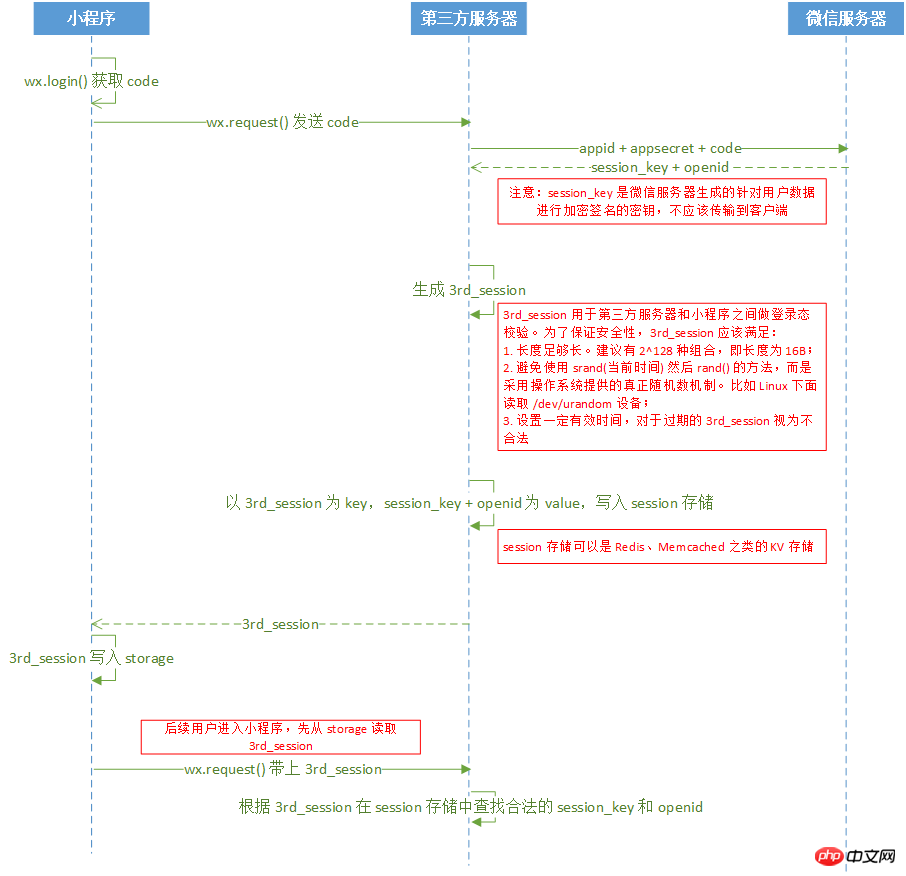Home > Article > WeChat Applet > Introduction to user data decryption in WeChat mini programs
This article mainly introduces relevant information about the detailed introduction of WeChat Mini Program user data decryption. Friends in need can refer to
WeChat Mini Program User Data Decryption
Official guide chart:

Step-by-step guide chart
1. Obtain code
onLoad: function (options) {
// 页面初始化 options为页面跳转所带来的参数
let that = this
wx.login({
success: function (res) {
// success
let code = res.code
that.setData({ code: code })
wx.getUserInfo({
success: function (res) {
// success
that.setData({ userInfo: res.userInfo })
that.setData({ iv: res.iv })
that.setData({ encryptedData: res.encryptedData })
that.get3rdSession()
}
})
}
})
}
2. Send code to the third-party server and obtain 3rd_session
get3rdSession:function(){
let that = this
wx.request({
url: 'https://localhost:8443/get3rdSession',
data: {
code: this.data.code
},
method: 'GET', // OPTIONS, GET, HEAD, POST, PUT, DELETE, TRACE, CONNECT
// header: {}, // 设置请求的 header
success: function (res) {
// success
var sessionId = res.data.session;
that.setData({ sessionId: sessionId })
wx.setStorageSync('sessionId', sessionId)
that.decodeUserInfo()
}
})
}
3. Send appid on the third-party server. Go to the WeChat server for appsecret and code in exchange for session_key and openid
The server built using JFinal is used here
Redis configuration
public void configPlugin(Plugins me) {
//用于缓存userinfo模块的redis服务
RedisPlugin userInfoRedis = new RedisPlugin("userInfo","localhost");
me.add(userInfoRedis);
}
Get Third-party session
public void get3rdSession() {
//获取名为userInfo的Redis Cache对象
Cache userInfoCache = Redis.use("userInfo");
String sessionId = "";
JSONObject json = new JSONObject();
String code = getPara("code");
String url = "https://api.weixin.qq.com/sns/jscode2session?appid=wx7560b8008e2c445d&secret=f1af3312b7038513fd17dd9cbc3b357c&js_code=" + code + "&grant_type=authorization_code";
//执行命令生成3rd_session
String session = ExecLinuxCMDUtil.instance.exec("cat /dev/urandom |od -x | tr -d ' '| head -n 1").toString();
json.put("session", session);
//创建默认的httpClient实例
CloseableHttpClient httpClient = getHttpClient();
try {
//用get方法发送http请求
HttpGet get = new HttpGet(url);
System.out.println("执行get请求:...." + get.getURI());
CloseableHttpResponse httpResponse = null;
//发送get请求
httpResponse = httpClient.execute(get);
try {
//response实体
HttpEntity entity = httpResponse.getEntity();
if (null != entity) {
String result = EntityUtils.toString(entity);
System.out.println(result);
JSONObject resultJson = JSONObject.fromObject(result);
String session_key = resultJson.getString("session_key");
String openid = resultJson.getString("openid");
//session存储
userInfoCache.set(session,session_key+","+openid);
}
} finally {
httpResponse.close();
}
} catch (Exception e) {
e.printStackTrace();
} finally {
try {
closeHttpClient(httpClient);
} catch (IOException e) {
e.printStackTrace();
}
}
renderJson(json);
}
private CloseableHttpClient getHttpClient() {
return HttpClients.createDefault();
}
private void closeHttpClient(CloseableHttpClient client) throws IOException {
if (client != null) {
client.close();
}
}
ExecLinuxCMDUtil.Java
import java.io.InputStreamReader;
import java.io.LineNumberReader;
/**
* java在linux环境下执行linux命令,然后返回命令返回值。
* Created by LJaer on 16/12/22.
*/
public class ExecLinuxCMDUtil {
public static final ExecLinuxCMDUtil instance = new ExecLinuxCMDUtil();
public static Object exec(String cmd) {
try {
String[] cmdA = { "/bin/sh", "-c", cmd };
Process process = Runtime.getRuntime().exec(cmdA);
LineNumberReader br = new LineNumberReader(new InputStreamReader(
process.getInputStream()));
StringBuffer sb = new StringBuffer();
String line;
while ((line = br.readLine()) != null) {
System.out.println(line);
sb.append(line).append("\n");
}
return sb.toString();
} catch (Exception e) {
e.printStackTrace();
}
return null;
}
}
4. Decrypt user data
decodeUserInfo:function(){
let that = this
wx.request({
url: 'https://localhost:8443/decodeUserInfo',
data: {
encryptedData: that.data.encryptedData,
iv: that.data.iv,
session: wx.getStorageSync('sessionId')
},
method: 'GET', // OPTIONS, GET, HEAD, POST, PUT, DELETE, TRACE, CONNECT
// header: {}, // 设置请求的 header
success: function (res) {
// success
console.log(res)
}
})
}
console output result:

/**
* 解密用户敏感数据
*/
public void decodeUserInfo(){
String encryptedData = getPara("encryptedData");
String iv = getPara("iv");
String session = getPara("session");
//从缓存中获取session_key
//获取名称为userInfo的Redis Cache对象
Cache userInfoRedis = Redis.use("userInfo");
Object wxSessionObj = userInfoRedis.get(session);
if(null==wxSessionObj){
renderNull();
}
String wxSessionStr = (String)wxSessionObj;
String session_key = wxSessionStr.split(",")[0];
try {
byte[] resultByte = AESUtil.instance.decrypt(Base64.decodeBase64(encryptedData), Base64.decodeBase64(session_key), Base64.decodeBase64(iv));
if(null != resultByte && resultByte.length > 0){
String userInfo = new String(resultByte, "UTF-8");
System.out.println(userInfo);
JSONObject json = JSONObject.fromObject(userInfo); //将字符串{“id”:1}
renderJson(json);
}
} catch (InvalidAlgorithmParameterException e) {
e.printStackTrace();
} catch (UnsupportedEncodingException e) {
e.printStackTrace();
}
}
AESUtil.java
import org.bouncycastle.jce.provider.BouncyCastleProvider;
import javax.crypto.BadPaddingException;
import javax.crypto.Cipher;
import javax.crypto.IllegalBlockSizeException;
import javax.crypto.NoSuchPaddingException;
import javax.crypto.spec.IvParameterSpec;
import javax.crypto.spec.SecretKeySpec;
import java.security.*;
public class AESUtil {
public static final AESUtil instance = new AESUtil();
public static boolean initialized = false;
/**
* AES解密
* @param content 密文
* @return
* @throws InvalidAlgorithmParameterException
* @throws NoSuchProviderException
*/
public byte[] decrypt(byte[] content, byte[] keyByte, byte[] ivByte) throws InvalidAlgorithmParameterException {
initialize();
try {
Cipher cipher = Cipher.getInstance("AES/CBC/PKCS7Padding");
Key sKeySpec = new SecretKeySpec(keyByte, "AES");
cipher.init(Cipher.DECRYPT_MODE, sKeySpec, generateIV(ivByte));// 初始化
byte[] result = cipher.doFinal(content);
return result;
} catch (NoSuchAlgorithmException e) {
e.printStackTrace();
} catch (NoSuchPaddingException e) {
e.printStackTrace();
} catch (InvalidKeyException e) {
e.printStackTrace();
} catch (IllegalBlockSizeException e) {
e.printStackTrace();
} catch (BadPaddingException e) {
e.printStackTrace();
} catch (NoSuchProviderException e) {
// TODO Auto-generated catch block
e.printStackTrace();
} catch (Exception e) {
// TODO Auto-generated catch block
e.printStackTrace();
}
return null;
}
public static void initialize(){
if (initialized) return;
Security.addProvider(new BouncyCastleProvider());
initialized = true;
}
//生成iv
public static AlgorithmParameters generateIV(byte[] iv) throws Exception{
AlgorithmParameters params = AlgorithmParameters.getInstance("AES");
params.init(new IvParameterSpec(iv));
return params;
}
}
The above is the entire content of this article. I hope it will be helpful to everyone’s study. More Please pay attention to the PHP Chinese website for related content! Related recommendations:
The WeChat Mini Program realizes the function of saving pictures and sharing them to Moments
About the WeChat Mini Program Implementation of the collection function
How the WeChat applet obtains openid and user information
##
The above is the detailed content of Introduction to user data decryption in WeChat mini programs. For more information, please follow other related articles on the PHP Chinese website!